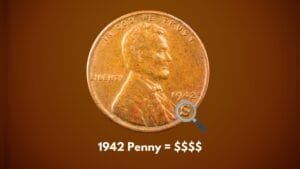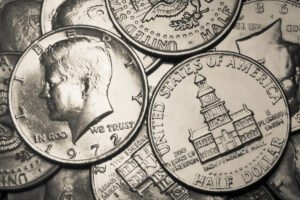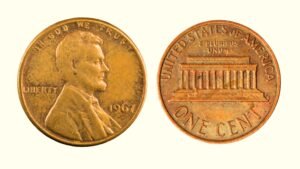Although common, the 1942 Lincoln Penny, a coin minted during one of America’s most tumultuous years, holds surprising value for coin collectors. While most circulated pennies are worth only a few cents, rare examples can command prices upwards of $15,000, making this wartime penny a hidden gem!
If you have this old pocket change cent, it’s time you find its real worth! This guide offers expert tips to spot a valuable 1942 Lincoln Wheat Penny and assess its value. From rare mint marks to coin errors, you will learn to trace all the unique features that could transform your penny into big bucks!
History of the 1942 Lincoln Penny
The Lincoln Penny, first introduced in 1909 to commemorate the centennial of Abraham Lincoln’s birth, had been a staple of American coinage for over three decades by 1942. Designed by Victor David Brenner, the coin featured Lincoln’s profile on the obverse and the iconic wheat stalks on the reverse, earning it the nickname “Wheat Penny.”
1942 was a year of profound change for the United States, as the nation had fully committed to the war effort. This also impacted the coinage. As strategic metals became crucial for military production, the government changed Lincoln Cent’s original copper composition to zinc-plated steel the following year.
Despite this, the U.S. Mint produced many 1942 Lincoln Wheat Pennies to meet its increased demand. The 1942 Lincoln Penny thus stands as a silent witness to a nation in transition, making it a poignant collector’s item beyond its monetary value.
| 1942 Lincoln Penny | Key Features |
| Coin Composition | Bronze (95% Copper, 5% Tin & Zinc) |
| Minting Location | Philadelphia, Denver & San Francisco |
| Year of Minting | 1942 |
| Face Value | One-cent |
| Weight | 3.11 grams |
| Diameter | 19.05 mm |
| Thickness | 1.52 mm |
| Designer | Victor David Brenner |
| Mint Marks | No Mint Mark (Philadelphia Mint) D-mint mark (Denver Mint) S-mint mark (San Francisco Mint) |
| Total Mintage | 950,116,000 |
Key Features to Spot a 1942 Lincoln Cent (Design & Composition)
You can easily identify a 1942 Lincoln Wheat Cent among old pennies by observing its distinct design on both sides and understanding its composition and dimensions.
1942 Lincoln Penny Obverse:
- Profile of Abraham Lincoln facing right
- The inscription “IN GOD WE TRUST” above Lincoln’s head
- “LIBERTY” to the left of Lincoln’s portrait
- Date “1942” to the right of Lincoln’s chest
- Designer’s initials “VDB” (Victor David Brenner) on Lincoln’s shoulder (visible under magnification)
- The mint mark (if present) below the date
1942 Lincoln Penny Reverse:
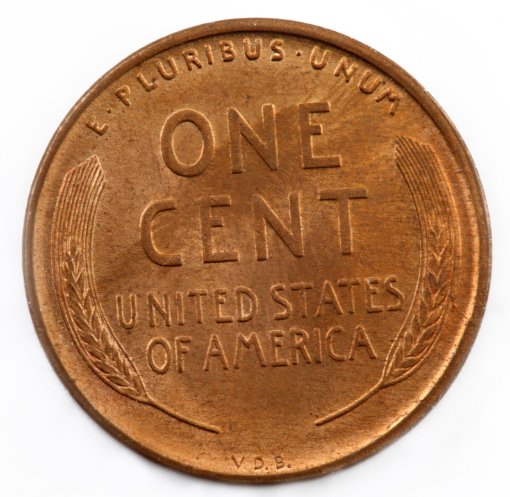
- Two wheat stalks framing the edges
- The motto “E·PLURIBUS·UNUM” across the top
- The face value “ONE CENT” in large lettering in the center
- “UNITED STATES OF AMERICA” below “ONE CENT”
Coin Composition, Size, & Dimensions:
The 1942 Lincoln Penny was composed of 95% copper and 5% tin and zinc. This composition, known as “bronze,” gave the coin its characteristic reddish-brown color when new and a weight of 3.11 grams (0.10970 ounces).
Due to wartime copper shortages, the coin’s composition changed from copper to steel in 1943, making the 1942 penny the last coin of the traditional bronze composition until late 1944.
As for the size, the 1942 Lincoln Penny features the traditional dimensions. It has a diameter of 19.05 mm (0.75 inches) and a thickness of around 1.55 mm (0.0610 inches) with a plain edge.
Finding the Value of 1942 Lincoln Penny (5 Factors)
The 1942 penny coin value can vary significantly based on several factors. On average, a circulated 1942 penny is worth between 3 to 5 cents. However, uncirculated coins or those with rare features can range from $1 to over $15,000, depending on the mint mark, condition, and the presence of errors or varieties.
Let’s understand these factors in detail.
1. Coin Grading and Condition
The condition of a 1942 Lincoln Penny significantly impacts its value. Coins are graded on a scale from Poor (P-1) to Perfect Mint State (MS-70). For 1942 pennies, coins in MS-65 (Gem Uncirculated) condition or higher tend to command premium prices.
The Sheldon Scale, used for grading coins, considers factors such as wear, luster, and the presence of contact marks. Higher grades (MS-65 to MS-70) can dramatically increase a coin’s value. For instance, a 1942-S penny in MS-65 Red condition might be worth $10, while the same coin in MS-67 Red could fetch over $1,000.
| Coin Grades | 1942 Penny No Mint Mark Value | 1942-D Penny Value | 1942-S Penny Value |
| Poor (0) to Extremely Fine (XF45) | Face value | Face value or a few cents more | Face value or a few cents more |
| Almost Uncirculated (AU50) to Mint State (MS60) | Below $2 | Below $2 | Below $2 |
| Mint State (MS61 – MS64) | $2 – $10 | $3 – $15 | $5 – $15 |
| Mint State (MS65 – MS66+) | $10 – $60 | $10 – $80 | $15 – $80 |
| Mint State (MS67 – MS68) | $100 – $3,500+ | $100 – $10,000+ | $120 – $12,500+ |
2. Coin Toning & Coloration
The color of a 1942 Lincoln Penny is crucial in its grading and valuation. Over time, copper coins naturally change color due to oxidation. Numismatists classify Lincoln Pennies into three color categories:
- Red (RD): These coins retain at least 95% of their original mint luster. They appear bright orange to light red in color. Red pennies are the most valuable, especially in high grades.
- Red-Brown (RB): These coins have 5% to 94% of their original red color remaining. They show a mix of red and brown tones. Red-Brown pennies are less valuable than Red but more valuable than Brown.
- Brown (BN): These coins have less than 5% of their original red color remaining. They appear mostly brown, ranging from light to dark shades. Brown pennies are typically the least valuable of the three categories.
3. Mint Marks & Mintage
The total mintage for 1942 Lincoln Pennies across all mints was a substantial 1,206,714,000 coins. You can identify the pennies struck by different mints by the mint mark located on the coin’s obverse below the date.
| 1942 Lincoln Penny Mint Marks | Total Mintage |
| 1942 No Mint Mark Penny | 657,796,000 |
| 1942-D Penny | 206,698,000 |
| 1942-S Penny | 85,590,000 |
The breakdown by mint and their respective values are as follows:
- 1942 No Mint Mark Penny: The Philadelphia Mint produced the highest number of pennies in 1942. In uncirculated condition (MS-65 Red), these coins can be worth between $7 to $10, while circulated examples typically trade at face value or slightly above. High-grade mint cents can fetch $100 to $1,000 or more.
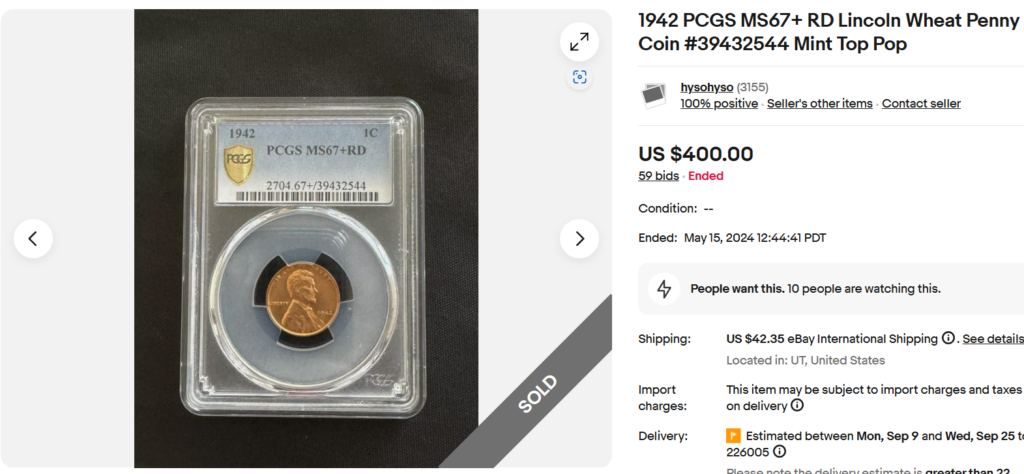
- 1942-D Penny: Denver minted significantly fewer pennies than Philadelphia and, hence, these pennies are slightly less common. The value of circulated 1942-D pennies is generally a few cents above face value, but mint state coins (MS67 or above) can be worth $100 to $10,000.
- 1942-S Penny: The San Francisco Mint produced the lowest 1942 pennies, making the 1942-S cents even less common than the 1942 no mint mark penny and 1942-D penny. Pristine, high-grade mint pennies, like an MS67+ RD or MS68 RD, can fetch up to $300 to $2,000+, as this example sold for $12,000 on Heritage Auctions.
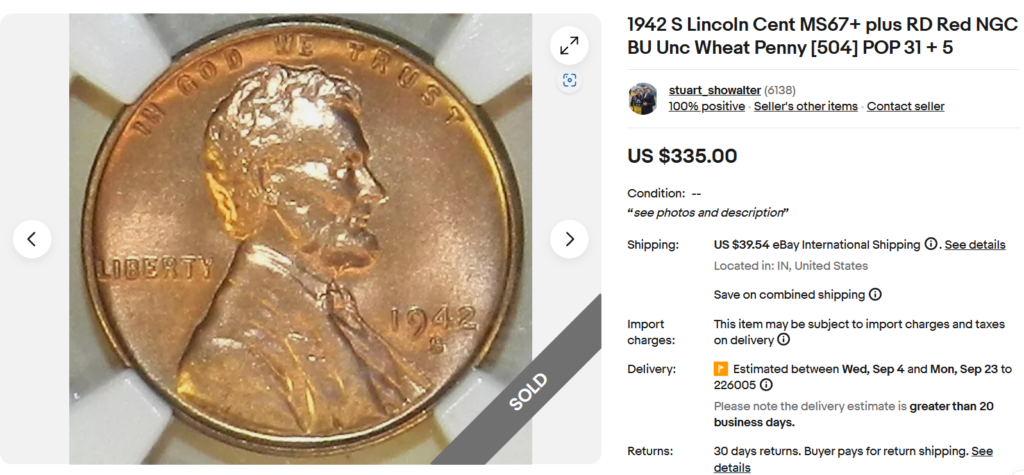
4. 1942 Lincoln Wheat Penny Proof Coins
Apart from the regular pennies, the Philadelphia Mint also minted 32,600 high-quality proof pennies in 1942 for collectors. These coins feature a mirror-like finish and stunning details on the devices, which increase their worth.
According to PCGS, the value of a 1942 Lincoln Penny proof coin depends on the coin’s color: red, red-brown, or brown. Among these, RD 1942 pennies with high proof grade (PR67 or above) can be worth around $2,000 – $5,000.
In addition to colors, 1942 proof cents are also categorized as “Cameo Proof” coins, which have a stronger contrast between the mirror-like fields and the raised designs than the regular ones. Due to their extremely sharp details and shiny appearance, these small cents are highly collectible, fetching up to $500 – $1,000 in recirculation condition (PR-65).
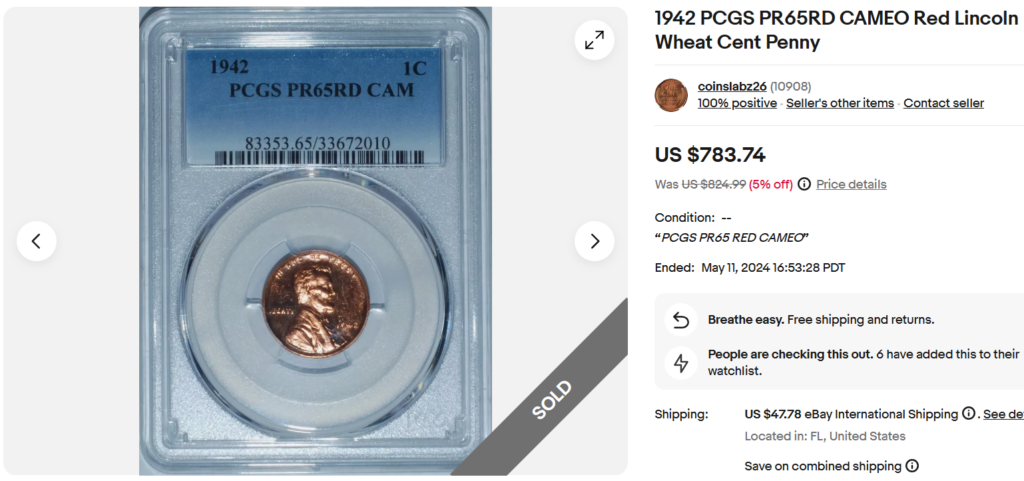
Higher PR-grade examples, such as PR67 or above, can fetch as much as $15,000. One such rare PR67-graded 1942 1C coin sold for a whopping $17,625 on Heritage Auctions.
5. Rare Mint Errors & Varieties of 1942 Wheat Penny
Mint errors and rarities can significantly increase the value of a 1942 Lincoln Penny. To spot these errors, use a magnifying glass or coin loupe and compare your coin to known normal specimens. Here are some notable errors and varieties you must look out for:
1. Double Die Obverse (DDO)
This error occurs when the die used to strike the coin is doubled during the rubbing process. To identify this coin error, look for a doubling in the letters of “IN GOD WE TRUST” and “LIBERTY” and the date “1942.”
Depending on the severity, a strong DDO can increase the value to $100-$500 or more. I found an MS63 BN 1942 No Mint Mark DDO penny that sold for almost $400 just because of the error. Regular MS63 BN 1942 pennies are only worth $5 – $10.

2. Repunched Mint Mark
This coin error results from the mint mark (S or D) being punched twice or multiple times at slightly different angles. To spot this, examine the mint mark under magnification. The value of 1942 pennies with RPM error depends on the coin’s condition, color, and mint mark.
Common varieties of this error coin are 1942-D/D 1C, 1942-S/S 1C, and 1942-S/S/S 1C. Among these, the 1942-S/S/S 1C coins are the most valuable, fetching up to $1,000 or above in MS66 or MS66+ condition, like this example that sold for $840 on Heritage Auctions. Another MS67 RD-graded example sold for $2,349 on eBay.
The 1942-S/S and 1942-D/D 1C coins are worth $500 to $1,500 in Mint State.
3. Off-center Strike
When a 1942 Lincoln Cent is struck off-center, part of the design will be missing, and a blank crescent will be on the coin. The value depends on how off-center the strike is and whether the date is visible.
Slightly off-center coins (10-30%) might be worth $20-$50, while severely off-center 142 Lincoln cents can fetch $200 or more.
Transitional Errors
When a certain coin is struck on a different planchet than the one assigned to it, the result is a transitional error. You can find the following planchet errors on a 1942 Lincoln Penny:
4. Struck on a Brass Planchet
This rare error coin is produced when a 1942 Lincoln Cent is struck on a Brass Planchet instead of a copper planchet. Extremely rare to find, this penny can be worth $200 – $400 in lowly Very Fine grades, such as VF34 or above, like this VF35-graded example that sold for over $320 on Heritage Auctions.
5. Struck on a Foreign Planchet
This is another transitional error that happens when a 1942 Lincoln Wheat Penny is struck on a foreign coin planchet. Only a few examples of this rarity have been graded by PCGS or NGC so far. One of these, an MS62 BN example, sold for a stunning price of $6,600 on Heritage Auctions.
6. Struck on a Dime Planchet
This 1942 Wheat Penny struck on a dime planchet is another rare coin to look for. You can spot it by the coin’s composition and the edge, which is almost cut off. This coin is also quite rare and, hence, fetches premium prices even in Almost Uncirculated condition. For instance, an AU58 1942 Lincoln Penny Dime coin sold for $2,990.
Remember, authentication by a professional grading service is recommended for potentially valuable error coins.
5 Easy Steps to Spot a 1942 Lincoln Penny Counterfeit
- Check the Weight & Dimensions: A genuine 1942 Lincoln Penny should weigh 3.11 grams and have a diameter of 19 mm. Use a precise digital scale and calipers for accurate measurements. If the numbers don’t match, the coin is likely fake.
- Examine the Mint Mark: Look for the mint mark (S or D), if present, below the date on the obverse. Philadelphia-minted coins have no mint mark. Ensure the mint mark is not artificially added or altered and matches the style used in 1942.
- Observe the Edge: The edge of a 1942 wheat penny should be plain, not reeded.
- Analyze the metal composition: Real 1942 Lincoln Pennies are made of 95% copper and 5% zinc and have a reddish-brown color tone. Be wary of any coin claiming to be aluminum, as these are likely fake.
- Do a Magnetic Test: Genuine 1942 Lincoln Pennies should not be magnetic. If the coin is attracted to a magnet, it’s likely counterfeit.
The 1942 Lincoln Penny, while common in circulated grades, offers much more monetary potential than you think. From mint-state red cents to intriguing error coins, this pre-wartime penny can hold surprising value. So, use this guide to find out the true worth of your coin!
If you love collecting pennies, do look out for other Lincoln cents, such as the 1943 Penny, the 1944 Penny, the 1983 Penny, the 1909 VDB Penny, and the 1964 Penny! You can learn to value these special coins with my detailed guides!
Note: This article is intended for informational, educational, and entertainment purposes only. Some images are illustrative and may not represent actual brands, products, or related entities. All trademarks, product names, brand logos, packaging, and other intellectual property referenced remain the exclusive property of their respective owners. Any brand mentions or references are provided solely for descriptive and educational context and do not imply any formal or commercial association.

